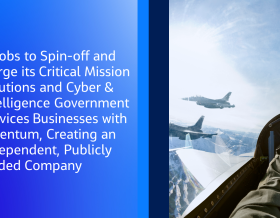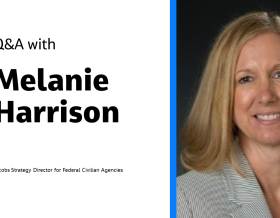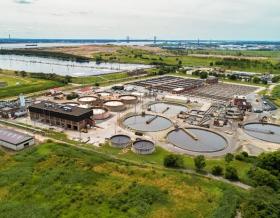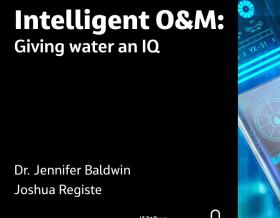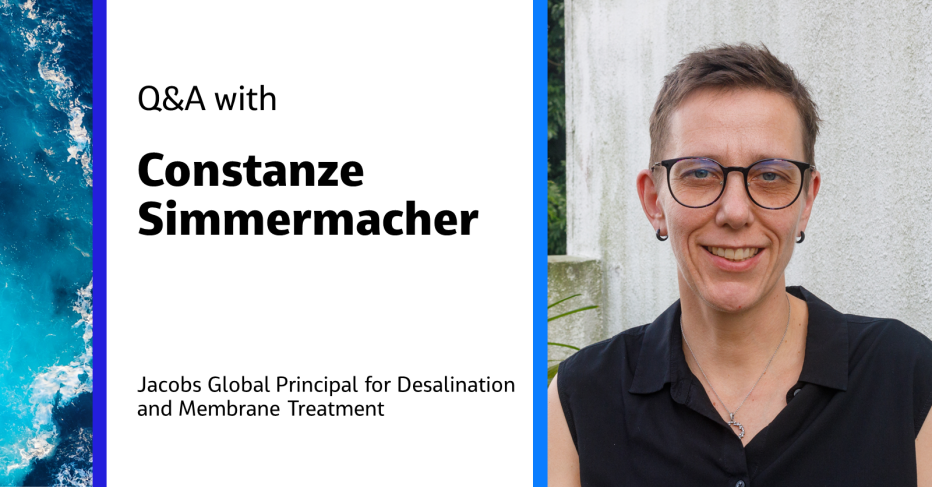
As water scarcity challenges intensify due to climate change, the need for reliable, drought-resilient water supplies is increasing worldwide. In response, more communities are embracing the OneWater principle that all water has value and turning to unconventional water sources to meet their supply needs.
By adopting desalination solutions, communities can convert seawater and other saline water sources into high-quality water supplies. Desalination facilities typically use reverse osmosis (RO) membrane treatment technologies to remove dissolved salts and minerals. These technologies involve passing water under high pressure through a semi-permeable membrane, separating out the clean water and concentrating the salts as a waste brine.
Jacobs has extensive experience delivering desalination projects worldwide. For more than 40 years we’ve been actively involved in academic and practical research, pilot-testing of desalination technologies as well as delivering the design, construction and operation of pioneering desalination systems.
In this Q&A, we connect with Jacobs Global Principal for Desalination and Membrane Treatment Constanze Simmermacher. Constanze studied water science in Germany – inspired by her dad who pursued the same field. Her career journey began with designing industrial water and wastewater treatment plants as a contractor. She came to Singapore on what was originally planned as a two-week trip – and never left! Constanze now serves as portfolio manager for the water and wastewater treatment plants that Jacobs supports in Singapore and, in her role as global principal, works on desalination and other advanced water treatment projects worldwide.
Hi Constanze, what are some of the key water challenges we’re solving for our clients with desalination?
Desalination is key to addressing water scarcity. It’s a solution to water resource issues in areas where water is hard to come by. I live and work in Singapore, where I’ve been fortunate to witness firsthand how desalination can help alleviate water scarcity – a longstanding and pressing issue for the island nation.
Though surrounded by water, the city-state’s limited land mass and lack of natural water bodies have made water security a priority since gaining independence in the 1960s. With most of its water imported from a neighboring country, Singapore proactively seeks to expand and diversify its water resources to bolster water resilience and self-sufficiency, prompting strategic planning and innovative ideas to secure a sustainable water supply. This effort saw the culmination of its national strategy, focusing on diversifying water resources through “four national taps”: water from the local catchment, imported water, high-grade reclaimed water known as NEWater and desalinated water. For more than two decades, our team has been proud to work closely with Singapore’s National Water Agency PUB on the implementation of its integrated, sustainable and resilient water master plan, most recently designing the Changi NEWater Factory 3.
As one of the four national taps, Singapore has continuously expanded its desalination capabilities. There are currently five desalination plants in Singapore, beginning with the SingSpring Desalination Plant, which was established in 2005.
In 2016, I had the opportunity to play a role in the development of its third plant, the Tuas Desalination Plant (TDP), which has the capacity to treat up to 136 million liters per day. From my role as process lead engineer during stages one and two – where I contributed to the development of the plant design and tender documents – to overseeing construction as commissioning manager, I gained invaluable experience throughout the project.
On another first-of-its-kind project, our team conducted the feasibility study for the Marina East Desalination Plant – where I assumed the role as process lead. The variable salinity plant – operational since 2021 – boasts the capability to treat both reservoir water and seawater, marking a significant advancement in Singapore's adoption of cutting-edge technology to tackle water security challenges.
More recently, I served as process lead for Singapore’s latest desalination plant on Jurong Island, which can produce up to 136 million liters per day. A key highlight of this project is its strategic co-location with Tuas Power’s Tembusu Multi-Utilities Complex, enabling synergies in resources and infrastructure including seawater intake, water-discharge facilities, elevated feed water temperature and energy. This integration makes it more energy-efficient than conventional desalination plants.
Together, the five desalination plants currently contribute up to 40% of the nation’s water supply capacity, underscoring the significant role that desalination can play in tackling water scarcity. With ongoing efforts to innovate and invest in water infrastructure, desalination stands as a vital component in Singapore's aspiration for water independence amidst its growing population and environmental uncertainties.
Climate change is seeing in more communities turn to desalination as a resilient water supply strategy. What technological innovations have made these solutions more accessible?
Due to the growing water crisis in many parts of the world, RO systems and membrane technology have gained prominence and undergone significant improvements. High-performing membranes with better permeability have improved system recoveries and are now readily available at a reasonable cost.
However, desalination remains a highly energy-intensive process. Encouragingly, there have been notable advancements on energy recovery devices to reduce energy consumption of the RO systems significantly. That’s been a big factor in reducing the operations and maintenance costs over the years so that this is now a more accessible solution for many clients.
Another emerging trend is the integration of renewable energy, such as wind and solar power with desalination plants, to reduce the associated carbon footprint and energy costs of desalination further. In regions like the Middle East, there is notable surge of interest and demand for solar panels to power desalination processes. This strategic shift aligns well with our multi-sector expertise across water and energy & power, positioning us effectively to support our clients in adopting a cleaner and more affordable energy future to sustain water plants.
What are the other key developments you’re seeing right now in desalination solutions?
Another major trend right now is the adoption of high-recovery systems to extract the maximum amount of water from the plant. This approach allows for the downsizing of pre-treatment components and reduces the size of the intake and outfall systems. Even though the high-recovery systems may incur higher initial costs, they streamline upstream processes, ultimately leading to cost savings and reduction in waste brine production. This brings the operations closer to achieving zero liquid discharge. Managing the brine production in desalination is a challenge that can be costly, so efforts to minimize brine volumes through higher water recovery are often very beneficial.
At the same time, there is a growing focus on treating brine as a resource. Extracting valuable minerals and metals like lithium, magnesium and potassium from brine has become increasingly feasible. This approach not only transforms waste into a valuable resource but also contributes to circular economy principles and minimizes environmental impacts associated with brine disposal. A recent study in Saudi Arabia revealed that mineral recovery could also potentially offset the costs of water production by commercializing extracted resources. This suggests the possibility of producing desalinated seawater at minimal to no cost.
This is also evident in water reuse plants – such as those currently being designed and developed in Singapore, where innovative technologies such as flow reversal technology are incorporated to boost recovery rates.
Ultimately, the trend we’re seeing today is very much focused on maximizing the efficiency of desalination or membrane treatment plants while minimizing brine production, which reflects a positive shift toward sustainability and resource optimization in water management.
What do you like most about being part of #OurJacobs team?
Besides the great people and unlimited opportunities to work on unique projects, what truly stands out for me is the access to a global expert network and support system. I find it truly reassuring to know that there will always be someone I can turn to for specialist advice. We have such a diverse pool of talented individuals and capabilities that there is always guidance and support available when needed. That’s something I always missed before I joined Jacobs.
About the interviewee

Constanze Simmermacher is Jacobs Global Principal for Desalination and Membrane Treatment and also serves as Portfolio Manager Treatment Plant Projects and Process Engineering Lead – Singapore. With 20 years of experience in process engineering and project management within the water and wastewater treatment domain, she distinguishes herself as a dedicated water process engineer committed to creating sustainable water solutions. Constanze’s experience covers feasibility studies, conceptual and detailed design as well as construction management and commissioning. Constanze has been involved and held responsible positions in the design, engineering and execution of projects involving key water and wastewater technologies. Her portfolio includes expertise in the treatment of surface water, desalination and water reuse, with this experience being applied to projects across Europe, Asia and the Middle East.
You might be interested in...
Join #OurJacobs team
What drives you drives us as we work to build a better world – together. At Jacobs, every day is an opportunity to make the world better, more connected, more sustainable. We’re always looking for dynamic and engaged people to join our team. Bring your passion, your ingenuity and your vision.

